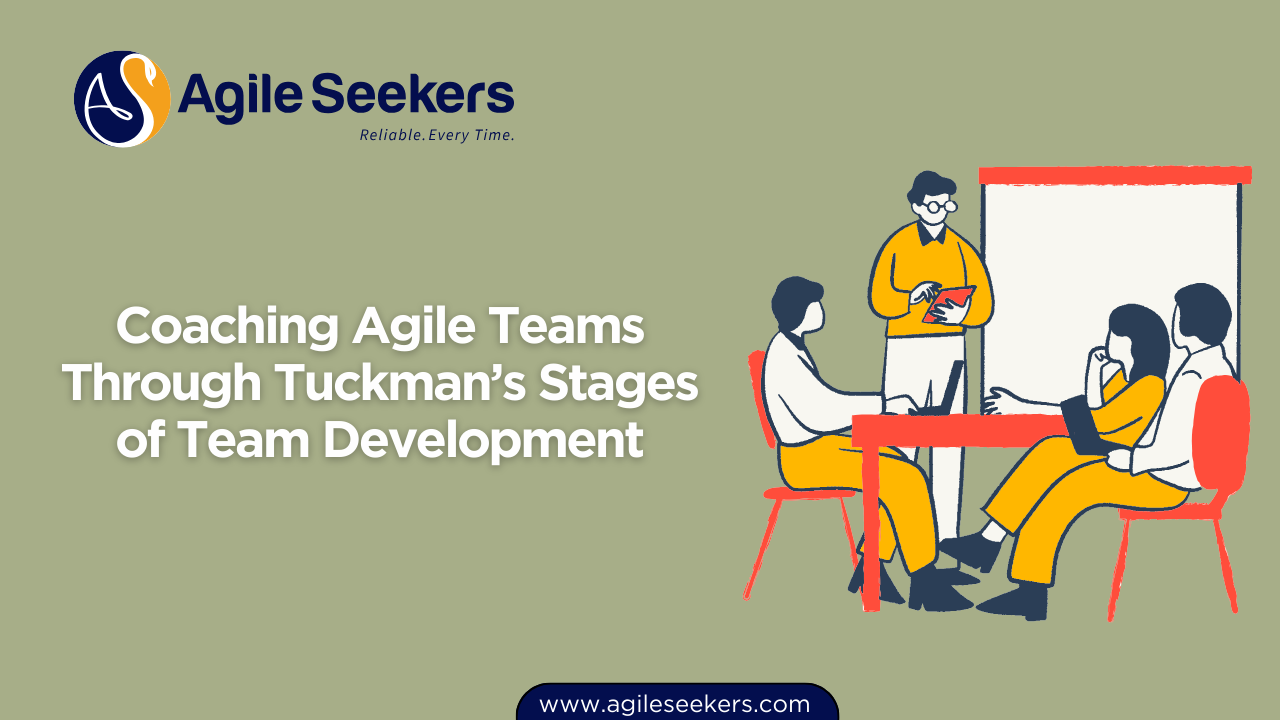Coaching Agile Teams Through Tuckman’s Stages of Team Development

Agile teams don’t magically achieve high performance. They evolve through stages—forming, storming, norming, performing, and adjourning—just as psychologist Bruce Tuckman outlined. An Agile coach or Scrum Master must understand how to guide teams through each of these stages with clarity, patience, and practical interventions. This blog explores how to coach Agile teams through Tuckman’s model, with actionable techniques aligned with Scrum principles.
Understanding Tuckman’s Model in the Agile Context
Tuckman’s model describes how teams mature over time:
-
Forming – Team members get to know each other, often avoiding conflict.
-
Storming – Personalities clash, roles blur, and trust is tested.
-
Norming – The team begins to agree on ways of working together.
-
Performing – Collaboration becomes seamless, and the team delivers consistently.
-
Adjourning – Teams disband after completing a project or initiative.
In Scrum teams, these stages often overlap with Sprint cycles. A Scrum Master must coach the team through these transitions, ensuring alignment with Agile values and delivery goals.
Stage 1: Coaching in the Forming Stage
During forming, team members rely heavily on the Scrum Master to guide them. They often lack clarity on roles, expectations, and workflows.
What Coaches Should Do:
-
Set expectations: Establish team agreements, definitions of roles, and basic ceremonies.
-
Introduce Scrum mechanics: Explain the purpose of the Daily Scrum, Sprint Planning, and Retrospectives.
-
Foster safety: Encourage open dialogue and emphasize psychological safety from day one.
🔗 Learn how certified scrum master training equips professionals to build team foundations early.
Key Focus Areas in Forming:
| Focus Area | Coach’s Role |
|---|---|
| Orientation | Facilitate introductions and team charter creation |
| Roles | Clarify Product Owner, Scrum Master, and Developer responsibilities |
| Process | Walk through Scrum events and artifacts |
Stage 2: Navigating the Storming Stage
Storming is the most volatile phase. Disagreements, confusion, and blame may arise. This is where coaching matters most.
Coaching Focus:
-
Address conflict without delay. Use facilitation techniques to surface and resolve issues constructively.
-
Encourage team accountability rather than top-down management.
-
Coach through role confusion—many new teams struggle with overlapping responsibilities.
💡 Refer to this Harvard Business Review article on managing team conflict to support your coaching practices.
Coaching Techniques for Storming:
-
Conflict Mapping: Visualize sources of conflict and resolve them collaboratively.
-
One-on-One Check-Ins: Support individual growth without undermining the team dynamic.
-
Values Alignment Workshops: Revisit the Scrum values—commitment, courage, focus, openness, and respect.
Stage 3: Reinforcing the Norming Stage
By now, the team starts creating working agreements organically. They adopt rituals and begin collaborating with minimal prompting.
As a Coach:
-
Step back, but stay available. Support autonomy without becoming invisible.
-
Encourage continuous improvement through Retrospectives.
-
Solidify norms like pair programming, code reviews, or async standups.
📘 Teams can benefit from structured csm training to deepen their understanding of team dynamics and Agile values.
Key Norming Actions:
| Activity | Coach's Input |
|---|---|
| Retrospective insights | Help team identify patterns and areas to improve |
| Peer feedback loops | Introduce 360-degree feedback mechanisms |
| Cross-functional growth | Encourage skill-sharing and collective ownership |
Stage 4: Amplifying the Performing Stage
Here, the team functions with high trust and autonomy. As a coach, your role becomes less directive and more strategic.
Coach’s Role in Performing:
-
Optimize flow and value delivery, not just velocity.
-
Challenge the team to push beyond their comfort zone while maintaining sustainable pace.
-
Introduce metrics like cycle time, flow efficiency, and defect rates—not as tools of judgment, but reflection.
💬 Read how high-performing teams manage themselves in this article by McKinsey on team performance.
🎓 Scrum Masters in this phase leverage their skills from CSM certification training to coach at the system level.
Stage 5: Managing the Adjourning Stage
Often overlooked, this stage is critical—especially in project-based or time-boxed teams. Teams may feel loss or anxiety about the future.
How to Coach:
-
Celebrate accomplishments. Reflect on successes and lessons learned in a final retrospective.
-
Facilitate knowledge transfer to other teams or projects.
-
Support transitions, whether team members are moving to new roles or forming new teams.
Agile Coaching Across Stages: Common Pitfalls
Even experienced Scrum Masters can fall into traps during different stages. Here’s a quick comparison of what to avoid:
| Stage | Common Pitfall | How to Avoid It |
|---|---|---|
| Forming | Over-structuring the team | Allow flexibility while introducing boundaries |
| Storming | Avoiding conflict | Facilitate healthy disagreement to build trust |
| Norming | Becoming complacent | Keep momentum with iterative improvements |
| Performing | Stepping away too far | Stay observant, coach for long-term sustainability |
| Adjourning | Ignoring closure rituals | Celebrate, reflect, and create a sense of completion |
Final Thoughts: Building Resilient Agile Teams Takes Intentional Coaching
Every Agile team moves at its own rhythm. Your job as a Scrum Master is to be present, adaptable, and committed to the team’s evolution. Recognize that setbacks may happen—but with coaching rooted in Tuckman’s framework, teams gain clarity and cohesion over time.
If you're looking to strengthen your capabilities as a Scrum Master and guide teams effectively through these stages, consider enrolling in a CSM certification program. It offers the foundational tools and techniques to lead Agile teams with confidence.
Alo read - Planning Poker Techniques
Also see - A Guide for Scrum Masters Using Jira and Confluence




















